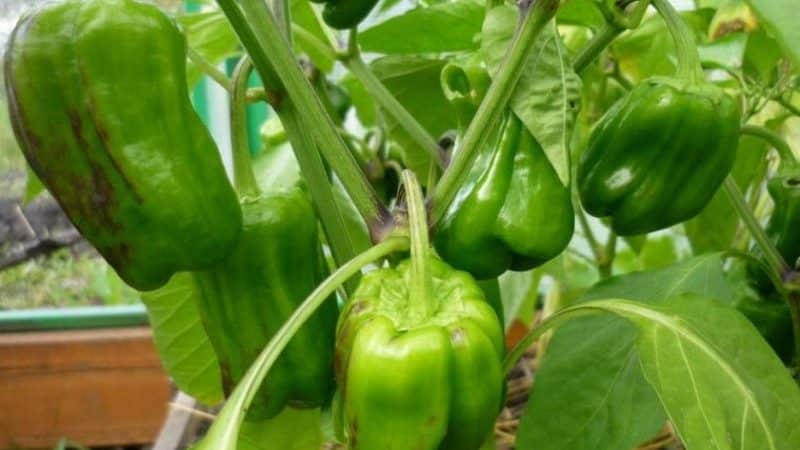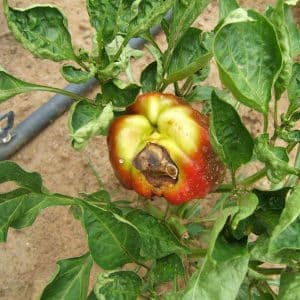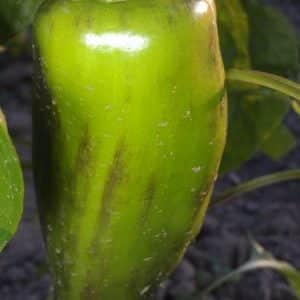What to do if pepper fruits turn black: identify the cause and effectively combat it
The appearance of black spots on pepper fruits is a dangerous signal for a gardener, indicating that the plant is infected with a fungus or bacteria. When pepper fruits turn black, you need to immediately begin treatment with chemicals and fertilizing to stop the spread of the disease.
Possible causes of blackened peppers
Why do pepper fruits turn black? Blackening in most cases is an indicator of serious and contagious diseases, less often - a consequence of a sharp temperature change or exposure to pests. Dark spots often appear on both the fruit and leaves. It is important to accurately establish the cause of the darkening: if the disease is contagious, the infection can quickly spread to the entire seedling.

Alternaria blight
The pathogenic fungus Alternaria solani, which is dangerous for nightshade crops, causes Alternaria blight. The fungal pathogen multiplies rapidly after heavy rainfall and hot weather. Characteristic symptoms of the disease:
- localization of blackening - fruit and leaves, spots first appear on the lower leaves, then necrosis spreads to the skin of the fruit in the area of the stalk, sometimes the stem is also affected;
- the color of the spots is from dark brown to black (the higher the humidity, the darker the plaque will be);
- development of the disease - individual round spots with a diameter of less than 20 mm appear on the pepper, which grow and unite over time.
In the final stages of Alternaria blight, the pepper dries out and dies.
Important! Even small speck indicates the penetration of mycelium into the fruit, which will lead to infection of the seeds.
Late blight
Phytophthora refers to a genus of fungus-like organisms that cause infection of nightshade crops. The causative agents of late blight live in the ground, so peppers can become infected from a neighboring potato or tomato bush.
Main signs of the disease:
- blackening is localized on the pepper skin, leaves and stems;
- the color of the spots varies from dark brown to black with a lighter frame; a whitish coating with fungal spores forms on top of the blackened area;
- the most dangerous period when most infections occur is when the fruits ripen, from July to early September.
Factors that provoke blackening of fruits due to late blight include a sharp decrease in temperature, high humidity, the use of ice water for irrigation and planting bushes too close.
Fusarium wilt
The disease is difficult to diagnose in the early stages. Noticeable deterioration occurs when the pepper can no longer be saved. The plant most often gets sick during the period of fruit set.
Stages of fusarium wilt:
- Yellowing and wilting of the upper leaves, despite abundant watering.
- Withered leaves become pale green or light brown.
- The area near the stalk is covered with black dents cracked from dryness. In case of high humidity, a fluffy pinkish coating appears on the blackened areas.
The infection remains in the soil and on the dead bush, posing a danger to other plants, for two to three years. Gardeners advise immediately digging up and burning a diseased plant to avoid an epidemic.There are no cures, only preventative measures.
Advice. You can protect peppers if you dip the seeds in Fundazol before planting.
Apical rot
Vershinnaya rot - a viral disease caused by calcium deficiency and excess nitrogen. A common mistake gardeners make that leads to damage to the skin is irregular watering, and peppers do not tolerate sudden changes in humidity.
First, barely noticeable translucent areas appear on the skin. After some time, the affected area will become rougher, dry, indented, and dark brown in color.
Black rot

Black or gray rot is a disease caused by a fungus. Mostly fruits are affected, less often - stems and leaves. The root always remains intact. After infection, gray areas appear on the skin, which darken over time. The pepper dies completely in 3-5 days.
There are 2 risk factors:
- high humidity;
- closely planted bushes.
Affected fruits cannot be saved, so they must be promptly removed. But the bush itself can survive if treated correctly.
Blackleg
The disease affects seedlings. The area between the upper root and the grafting site becomes soft and darkening occurs. The affected part of the seedling will soon dry out and shrink the root collar.
Risk factors:
- poorly ventilated seedlings;
- high humidity;
- hard crust on the soil surface;
- cold;
- tightly planted peppers.
It is impossible to save infected fruits. The seedlings are urgently removed from the soil to save the remaining plants. In the case of blackleg, only preventive measures are used to prevent infection of peppers.
Bacterial cancer of pepper
Cancer is caused by the aerobic bacterium Clavibacter michiganensis. The disease is rare and people are more susceptible to it greenhouse peppers, growing in warm regions. Not only the fruits, but also the stems and leaves suffer from cancer.
Symptoms of the disease:
- small blackening, which grow over time and unite into black ovals with a diameter of 2-3 cm;
- if pepper cancer is at an advanced stage, then the leaves lose color;
- When you lightly shake the bush, the leaves immediately come off.
Even after the death of the pepper, bacteria live in the dead bush and the soil around it, and therefore pose a danger to other plants. To stop mass infection, clean the soil 2-3 times a month.
Sclerotinia
The fungus attacks the lower part of the stems and the fruits of sweet and bitter peppers. Optimal conditions for the development of pathogenic microorganisms are humidity above 85% and temperature below +20°C.
Manifestations:
- the stem is covered with a whitish film - if you rub it, you can see the blackened areas of the tissue;
- pepper fruits soften and become overgrown with a similar film.
It is better to remove bushes affected by sclerotinia immediately.
Low temperature
Bell peppers do not tolerate sudden changes in temperature and have difficulty withstanding cold. In the event of an unexpected cold snap, the root system stops absorbing nutrients from the soil, and then the plant takes the substances necessary for life from the fruits and leaves. The shoots turn black first. You can save the pepper if you restore normal temperature conditions.
Pests
Blackening is caused by spider mites. Favorable conditions for the development of pests: heat, high humidity and stuffiness.
Characteristic signs of bush infection:
- dots on leaves and fruits, which after some time merge into a large spot;
- the color of the darkened area is dark brown;
- leaves and stems are tangled due to the constant movement of pests;
- the intertwined shoots dry out over time due to impaired respiratory functions, and the fruits die.
Due to attacks by spider mites, 50-60% of planted peppers may die. Chemical and traditional methods are effective in pest control.
Fighting methods
Most bacterial diseases that cause blackening of the skin cannot be treated. The diseased bush is dug up and the seedlings are destroyed. But some deviations can be stopped if diagnosed in a timely manner.
Chemical
The treatment method varies depending on the type of disease:
- Alternaria blight. To inhibit the necrotic process, the bush is sprayed 1-2 times per season with products based on strobilurins. During breaks, fungicides are used: “Tiovit Jet” and “Cumulus”.
- Late blight. The beds are treated with Alirin-B at the rate of two tablets per bucket, Fitosporin-M - 10 g diluted in 5 liters of liquid. The bushes are sprayed with “Gamair”; to prepare the solution, two tablets are diluted in 1 liter of water. If there are a lot of bushes, then the “Quadris” product will do.
- Apical rot. Fertilize with calcium chloride (0.4%) or calcium nitrate. During one growing season, fertilizing is done up to four times.
- Bacterial cancer. Peppers are sprayed with copper-based products.
- Blackleg. In the first stages, watering with a light pink solution of potassium permanganate will help.
Folk
Traditional methods are the most effective for combating spider mites:
- ½ laundry soap is dissolved in 5 liters of water. The mixture is used to treat the shoots.
- During the flowering period, henbane is collected.To process a bed you will need 2-2.5 kg. The grass is cut, boiled over low heat for 2.5 hours, filtered. Add regular water to the broth so that the total volume is 8 liters. The liquid is used for spraying.
- The shoots are wiped with ordinary alcohol. No need to add water.
Agrotechnical techniques
To stop the spread of infection, gardeners use the following techniques:
- complete removal of infected shoots;
- reducing irrigation volumes;
- steaming the soil in which pathogenic microorganisms have appeared;
- loosening the soil around the bushes;
- in case of excessive moisture, the soil is sprinkled with activated carbon, ordinary sand or ash;
- ventilation of the greenhouse.
If the seedlings become infected and die, then the same soil cannot be used for the next batch of peppers. Dangerous microorganisms remain in the soil, which will also kill new plants.
Features of problems and their treatment
The risk of contracting various bacterial and fungal infections varies depending on where the nightshade crop is grown. The variety has little effect.
In the greenhouse and in the open ground
Peppers growing in open ground in humid and hot climates are more likely to get sick and turn black. To reduce the risk of disease, choose a sunny, ventilated area for the garden bed.
The following rules apply for greenhouse crops:
- periodically the greenhouse needs to be ventilated and create a draft;
- to avoid waterlogging, water is poured under the bottom of the stem;
- Do not allow water to condense on the walls of the greenhouse.
The methods for treating peppers are similar: the same fertilizers will help. Only the methods of normalizing temperature and humidity levels differ.
For sweet pepper/for bitter pepper
Both types of peppers are demanding to care for.Sweet varieties suffer most from late blight. Bitters have a weak stem and root system, which is why such crops often die. It is important not to overdo it with watering and compacting the soil.
Advice from experienced agronomists
To protect nightshade crops from blackening, follow these recommendations:
- Be sure to take into account crop rotation - you cannot plant peppers in the same place every year, as there will not be enough phosphorus left in the soil. Suitable predecessor crops are peas, cabbage, carrots, beet, and pumpkin. Not suitable: potatoes, tomatoes and eggplants.

- Before planting, seeds are disinfected with special chemicals.
- For prevention in the spring, spraying is carried out with a 1% solution of copper sulfate and fungicides.
- If fungal pathogens multiply in the soil, fungicides are constantly used for seeds and bushes.
- All remains of dead plants are carefully removed from the site.
- Seeds of blackened fruits are not used.
- The bushes are planted at intervals from each other.
- Water for irrigation should be warm.
- The earth is constantly loosened to provide air access.
- Clear control of the volume of water for irrigation is important - excess moisture should not be allowed.
- Ash or lime is added to the soil to prevent infections; peat is prohibited.
Fruits and leaves are constantly inspected to identify blackening in time.
Conclusion
Peppers are a fairly resistant crop to fungi and viruses, but they still have a risk of becoming infected. If you forget about preventive measures and do not remove blackened bushes from the garden in time, you can lose the entire harvest. Blackening of pepper fruits is practically untreatable, since the disease is detected too late.